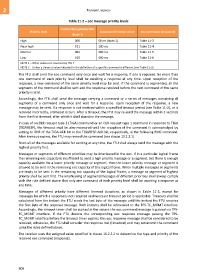Page 816 - 5G Basics - Core Network Aspects
P. 816
2 Transport aspects
Table 11-2 – eoc message priority levels
Control field priority bits
Priority level Associated timeout value eoc command (response)
(Note 1)
High 000 50 ms (Note 2) Table 11-3
Near high 011 100 ms Table 11-4
Normal 001 200 ms Table 11-5
Low 010 400 ms Table 11-6
NOTE 1 – Other values are reserved by ITU-T
NOTE 2 – Unless a timeout value indicated in the definition of a specific command is different (see Table 11-3).
The FTU shall send the eoc command only once and wait for a response, if one is required. No more than
one command of each priority level shall be awaiting a response at any time. Upon reception of the
response, a new command of the same priority level may be sent. If the command is segmented, all the
segments of the command shall be sent and the response received before the next command of the same
priority is sent.
Accordingly, the FTU shall send the message carrying a command or a series of messages containing all
segments of a command only once and wait for a response. Upon reception of the response, a new
message may be sent. If a response is not received within a specified timeout period (see Table 11-2), or is
received incorrectly, a timeout occurs. After a timeout, the FTU may re-send the message within 2 seconds
from the first timeout, after which it shall abandon the message.
In case of an OLR request type 3 (TIGA) command or an OLR request type 1 command in response to TIGA
(TIGARESP), the timeout shall be also measured until the reception of the command is acknowledged by
setting to ONE of the TIGA-ACK bit or the TIGARESP-ACK bit, respectively, in the following RMC command.
After timeout expires, the FTU may resend the command (see clause 13.2.2.1).
From all of the messages available for sending at any time, the FTU shall always send the message with the
highest priority first.
Messages or segments of different priorities may be interleaved in the eoc. If in a particular logical frame
the remaining eoc capacity is insufficient to send a high priority message or a segment, but there is enough
capacity available for a lower priority message or segment, then the lower priority message or segment is
allowed to be sent in the remaining eoc capacity of this logical frame. When multiple messages or segments
are ready to be sent in the remaining eoc capacity of the logical frame, a message or segment of highest
priority shall be sent first. The interleaving of segment/messages of different priorities shall always comply
with the rule defined above that only one command of each priority level shall be awaiting a response at
any time.
Messages of different priority have different timeout durations, as shown in Table 11-2, except for
messages for which a response is not required and hence no timeout period is applicable. Timeouts shall be
calculated from the instant the FTU sends the last byte of the message until the instant the FTU receives
the first byte of the response message. Both instants shall be referenced to the TPS-TC_MGMT interface.
Accordingly, the timeout timer shall be started at the instant the eoc command message is passed via TPS-
TC_MGMT interface. If the FTU detects the corresponding eoc response message passing the TPS-
TC_MGMT interface before the timeout timer expires, this eoc response message shall be considered to be
received; otherwise, the FTU shall consider the response lost (timedout) and may retransmit the command
using the rules defined above.
The receiver uses the assigned value specified in clause 11.2.2.2 to determine the type and priority of the
received eoc command (response).
806

